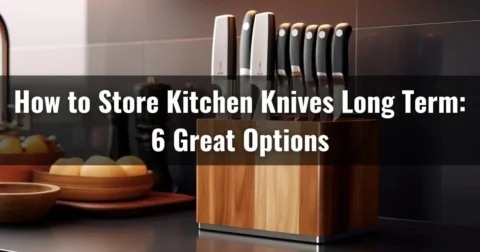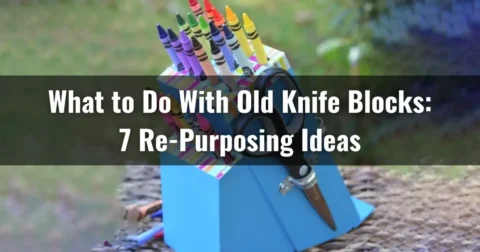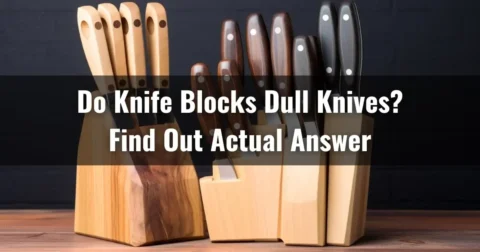Proper knife storage is a fundamental aspect of kitchen safety and the longevity of your culinary tools. The choice between using the knife block and magnetic strip can significantly impact your kitchen’s functionality and the condition of your knives.
The knife block offers a traditional storage method, keeping your knives neatly organized and within reach. There are designated slots for storing knives in an organized manner.
In contrast, the knife magnetic strip is a space-saving alternative, allowing easy accessibility and a sleek, modern look. The magnetic strips rely on magnetism and allow flexible placement of knives on a smooth surface.
This article will dive into the differences between the two knife storages, helping you understand the importance of keeping your knives safe and accessible. From organization to functionality, we’ll provide all the information you need to make an informed decision.
Jump to Section
Comparison Between Knife Block and Magnetic Strip for Knife Storage
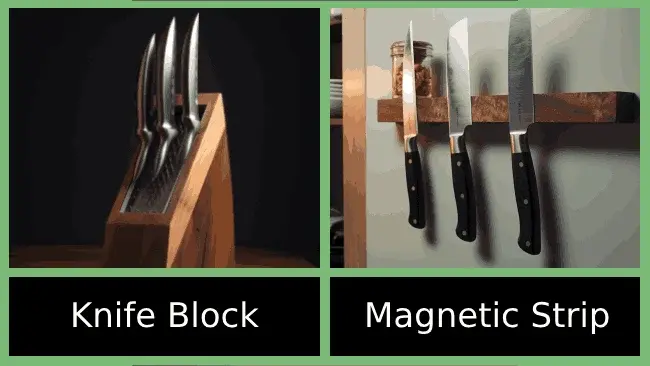
Knife block and magnetic strip are the most popular knife storage solutions. During our research, we found distinct differences between them.
- Storage method
- Space usage
- Accessibility
- Knife protection
- Hygiene and maintenance
- Knife compatibility
- Aesthetics
- Safety
- Additional features
- Installation
Let’s take a closer look at each factor to better understand the differences between knife block and magnetic strip.
No 01. Storage Method
Knife blocks are storage solutions in chunky wooden or metal holders equipped with designated slots to house kitchen knives securely. These slots are designed to keep each knife upright and in place, preventing them from touching other utensils.
The knife blocks can be placed on kitchen counters or within drawers, offering a traditional and organized approach to knife storage.
In contrast, magnetic strips use magnetism to hold knives in place securely, and they can be made of plastic, stainless steel, aluminum, or wood. They can be wall-mounted or affixed to any suitable vertical surface.
This storage method provides a minimalist and flexible approach to knife organization, as it doesn’t require specific slots for each knife.
No 02. Space Usage
While practical for kitchen organization, knife blocks tend to occupy valuable counter space or drawer real estate. This can be a drawback in smaller kitchens or for those who prioritize optimizing their workspace.
Conversely, magnetic strips are space-saving champions. Since they can be easily mounted on walls or other vertical surfaces, they help conserve valuable counter space.
No 03. Accessibility
Each knife has a designated slot in blocks to conveniently store knives and organize. Despite this, retrieving a specific knife may require some effort, as you need to locate the correct slot and remove the knife.
Meanwhile, magnetic strips provide a swift and hassle-free method for accessing knives. They allow you to simply reach for the desired knife without the need to navigate slots or drawers, making them highly efficient in busy kitchens.
No 04. Knife Protection

A knife block is a traditional option that securely houses each knife in its own slot, keeping the blades separated and reducing the risk of damage. This is especially beneficial for high-quality knives that you want to keep in pristine condition.
Alternatively, a knife magnetic strip offers a different type of protection. It securely holds the knives in place using powerful magnets, allowing for easy access while preventing blade-to-blade contact.
Also, the magnetic strip allows air circulation around the blades, which helps prevent moisture buildup and potential rusting.
No 05. Hygiene and Maintenance
With regards to hygiene and maintenance, the knife magnetic strip is easier to clean and maintain compared to the knife block.
Cleaning knife blocks can be a bit of a hassle. You must remove all the knives and thoroughly clean the slots, which can accumulate germs, debris, or food particles over time. This can be time-consuming and requires extra effort to ensure proper cleanliness.
Conversely, magnetic strips are a breeze to maintain. With their smooth surfaces, you can quickly wipe them clean with a damp cloth. This minimizes the risk of hidden dirt and grime buildup, keeping your knives and kitchen environment more hygienic.
No 06. Knife Compatibility
Knife blocks are specifically designed with predetermined slots, which may not accommodate knives of unusual shapes or sizes. This limitation can be a drawback if you have a diverse knife collection.
In contrast, magnetic strips offer versatility in accommodating knives of various shapes and sizes. This adaptability makes them an excellent choice for those with a wide range of kitchen knives.
No 07. Aesthetics
You can add timeless elegance to your kitchen with knife blocks. Some models feature beautiful wood or metal finishes that can complement a traditional kitchen aesthetic.
Meanwhile, magnetic strips provide a modern and minimalist look. Their sleek design can seamlessly blend with contemporary kitchen decor, offering a more subdued and unobtrusive appearance.
No 08. Safety
Knife blocks are known for their secure slots that encase the knives, minimizing the risk of accidental cuts when reaching for a knife. This makes them a safer option for households with children or pets.
On the other hand, if magnetic strips are not properly installed, there’s a potential safety concern with magnetic strips. Knives could fall from the strip, posing a risk to anyone in the kitchen. Therefore, it’s crucial to securely mount the strip to the wall, ensuring the safety of everyone in the kitchen.
No 09. Additional Features
Some knife blocks have extra features, such as built-in sharpening steel or kitchen scissors. These additional tools can enhance the functionality of the knife block and provide added value.
Conversely, magnetic strips focus solely on knife storage and do not incorporate additional built-in features. They offer a more straightforward and minimalist approach to knife organization.
No 10. Installation
While knife blocks offer convenience with their effortless setup, magnetic strips require more effort to install securely. The process typically involves drilling and mounting the strip on a wall or another suitable surface.
This ensures that the knives are held securely and safely in place. Proper installation is crucial to prevent any accidents or damage.
Alternatively, knife blocks require no installation. You simply place them in a drawer or on the kitchen countertop. This ease of setup makes them accessible to all users.
Comparison Table Between Knife Block and Magnetic Strip
| Aspect | Knife Block | Knife Magnetic Strip |
|---|---|---|
| Storage Method | Chunky holder with designated slots | Magnetized material |
| Space Usage | Takes up counter or drawer space | Space-saving, wall-mountable |
| Accessibility | Organized but may require effort to retrieve | Quick and easy access |
| Knife Protection | Separates knives, reduces blade contact | Securely holds knives, allows air circulation |
| Hygiene and Maintenance | Requires slot cleaning | Easy to wipe clean |
| Knife Compatibility | Not accommodate odd-sized knives | Accommodates various knife sizes and shapes |
| Aesthetics | Classic adds elegance to the kitchen | Modern and minimalist design |
| Safety | Generally safe, reduces accidents | Secure installation is crucial to prevent falls |
| Additional Features | Can include built-in sharpeners, scissors | Focuses solely on knife storage |
| Installation | No installation required | Requires drilling and secure mounting |
Why Should You Use Knife Blocks or Magnetic Strips?
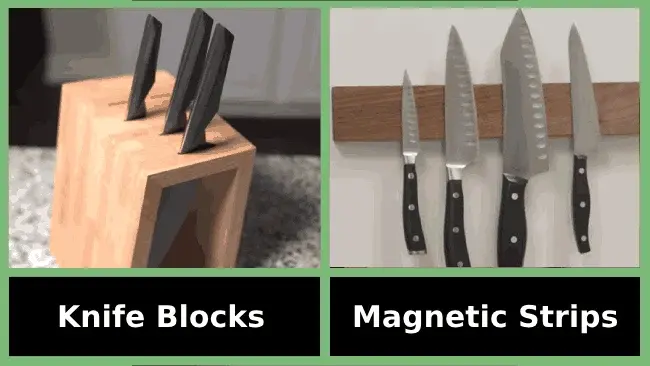
For several reasons, knives should be kept in a knife block or on a magnetic strip. As examples, we will provide the following:
Reduce Safety Hazards
When knives are left carelessly in drawers or on countertops, they can pose a serious safety hazard, especially when reaching for other utensils. By using a knife block or magnetic strip, knives are easily accessible yet stored safely in a designated space, reducing the risk of accidental cuts.
Blade Protection and Longevity
Knives left exposed can easily come into contact with other utensils, causing damage that shortens their lifespan. According to kitchen experts, knife magnetic strips offer blade protection and longevity, keeping sharp edges from getting dull quickly.
Optimized Kitchen Organization
A knife block or magnetic strip offers space optimization and ensures that knives are easily accessible when needed. It helps one quickly find the right knife they need for a specific task without rummaging through a cluttered drawer.
Hygiene and Sanitation
The stainless steel material used in knife blocks and magnetic strips is easy to clean and sanitize, minimizing the risk of bacterial growth. Having a designated storage space for knives prevents them from coming into contact with other kitchen tools that may harbor bacteria.
Aesthetic and Functional
A good quality knife block or magnetic strip can add to the overall aesthetic of a kitchen while keeping sharp blades safely contained and easily accessible. It can create a more professional and organized atmosphere in the kitchen that is conducive to cooking.
FAQ’s: Knife Block vs Magnetic Strip
Below are some commonly asked questions we found while researching and curating the best knife storage solution for you:
Do magnetic strips dull knives?
Using a magnetic strip to store your knives won’t dull them. In fact, it’s actually a great storage solution that helps to maintain the sharpness of your blades.
Unlike knife blocks or drawers, a magnetic strip keeps your knives in place without any unnecessary movement. This means that the blades won’t rub against each other or against any other surfaces, reducing the risk of dulling or damaging them.
Should knives go upside down in the knife block?
It is strongly suggested that you should consider placing your knives upside down in the knife block to prevent dulling.
When you store your knives with the blades facing up, the weight of the blade constantly presses down on the cutting edge. Over time, this can cause the blade to become dull and lose its sharpness.
By placing the knives upside down in the block, you’re allowing the weight of the blade to rest on the top of the holder rather than on the cutting edge.
Conclusion
Through the discussion above about knife blocks vs magnetic strips, it is evident that both have their own advantages for storing knives.
A knife block provides a secure and organized way to store knives, while a magnetic strip offers easy access and a sleek, modern look. Whether you prefer the traditional or contemporary approach, keeping your knives in either of these storage options ensures their longevity and safety.
In the end, the choice ultimately depends on your personal preference and kitchen style. Always store knives away from children, and keep the blades clean and dry to prevent rusting when not in use.


![Knife Block vs Magnetic Strip: 10 Differences [Explained]](https://tidytango.com/wp-content/uploads/2023/10/Knife-Block-vs-Magnetic-Strip-10-Differences-Explained-900x473.webp)
